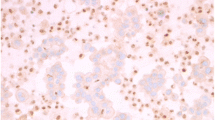Abstract
The differentiation between reactive mesothelial hyperplasia (RMH) and diffuse malignant peritoneal mesothelioma (DMPM) is challenging especially when applied on peritoneal small samples. The use of BRCA-associated protein 1 (BAP1) and methylthioadenosine phosphorylase (MTAP) immunostains is familiar to identify malignant mesothelial proliferation. Recently, nuclear 5-hydroxymethylcytosine (5-hmC) was reported to be a new recognition tool of pleural mesothelial malignancy on surgical specimens. However, application of 5-hmC immunostaining has not yet studied in peritoneal specimens from small biopsies or cytology cell-blocks. The aim was to assess the diagnostic accuracy of this new marker combination to distinguish DMPM from RMH in biopsies and cell-blocks. Seventy-five cases were analyzed; among which, 38 were of cytological specimens including 6 RMH and 32 DMPM, and 37 tissue biopsies with 7 RMH and 30 DMPM. BAP1, MTAP, and 5-hmC immunostains were performed on all cases. RMH cases exhibited a retained staining with all immunostains. Among DMPM, BAP1 was lost in 71.8% of cytology cell-blocks and 66.7% of biopsies. MTAP was lost in 40.6% of cytology cell-blocks and 33.3% of biopsies. 5-hmC was lost in 40.6% of cytology cell-blocks and 30% of biopsies. The combination of BAP1, MTAP, and 5-hmC showed the best accuracy in differential diagnosis between RMH and DMPM (sensitivity = 0.84, specificity = 1 in cytology cell-blocks; sensitivity = 0.90, specificity = 1 in biopsy). The best diagnostic combination in peritoneal cytology effusion fluids and biopsies samples provided by BAP1, MTAP, and 5-hmC should be applied on a diagnostic step-wise algorithm by pathologists involved into the management of DMPM, because of their therapeutic implications.



Similar content being viewed by others
References
Attanoos RL, Griffin A, Gibbs AR (2003) The use of immunohistochemistry in distinguishing reactive from neoplastic mesothelium. A novel use for desmin and comparative evaluation with epithelial membrane antigen, p53, platelet-derived growth factor-receptor, P-glycoprotein and Bcl-2. Histopathology 43:231–238. https://doi.org/10.1046/j.1365-2559.2003.01686.x
Bruno R, Alì G, Fontanini G (2018) Molecular markers and new diagnostic methods to differentiate malignant from benign mesothelial pleural proliferations: a literature review. J Thorac Dis 10:S342–S352. https://doi.org/10.21037/jtd.2017.10.88
Sheffield BS, Hwang HC, Lee AF et al (2015) BAP1 immunohistochemistry and p16 FISH to separate benign from malignant mesothelial proliferations. Am J Surg Pathol 39:977–982. https://doi.org/10.1097/PAS.0000000000000394
Hida T, Hamasaki M, Matsumoto S et al (2017) Immunohistochemical detection of MTAP and BAP1 protein loss for mesothelioma diagnosis: comparison with 9p21 FISH and BAP1 immunohistochemistry. Lung Cancer 104:98–105. https://doi.org/10.1016/j.lungcan.2016.12.017
Andrici J, Parkhill TR, Jung J et al (2016) Loss of expression of BAP1 is very rare in non-small cell lung carcinoma. Pathology 48:336–340. https://doi.org/10.1016/j.pathol.2016.03.005
Nasu M, Emi M, Pastorino S et al (2015) High incidence of somatic BAP1 alterations in sporadic malignant mesothelioma. J Thorac Oncol 10:565–576. https://doi.org/10.1097/JTO.0000000000000471
Chapel DB, Husain AN, Krausz T (2019) Immunohistochemical evaluation of nuclear 5-hydroxymethylcytosine (5-hmC) accurately distinguishes malignant pleural mesothelioma from benign mesothelial proliferations. Mod Pathol 32:376–386. https://doi.org/10.1038/s41379-018-0159-7
Mneimneh W, Jiang Y, Harbhajanka A, Michael C (2021) Immunochemistry in the work-up of mesothelioma and its differential diagnosis and mimickers. Diagn Cytopathol 49:582–595. https://doi.org/10.1002/dc.24720
Berg KB, Churg AM, Cheung S, Dacic S (2020) Usefulness of methylthioadenosine phosphorylase and BRCA-associated protein 1 immunohistochemistry in the diagnosis of malignant mesothelioma in effusion cytology specimens. Cancer Cytopathol 128:126–132. https://doi.org/10.1002/cncy.22221
Chapel DB, Schulte JJ, Berg K et al (2020) MTAP immunohistochemistry is an accurate and reproducible surrogate for CDKN2A fluorescence in situ hybridization in diagnosis of malignant pleural mesothelioma. Mod Pathol 33:245–254. https://doi.org/10.1038/s41379-019-0310-0
Rasmussen K, Helin K (2016) Role of TET enzymes in DNA methylation, development, and cancer. Genes Dev 30:733–750. https://doi.org/10.1101/gad.276568.115
Chapel DB, Schulte JJ, Husain AN, Krausz T (2020) Application of immunohistochemistry in diagnosis and management of malignant mesothelioma. Transl Lung Cancer Res 9:S3–S27. https://doi.org/10.21037/tlcr.2019.11.29
HusainA N, Colby TV, Ordóñez NG et al (2018) Guidelines for pathologic diagnosis of malignant mesothelioma: 2017 update of the consensus statement from the International Mesothelioma Interest Group. Arch Pathol Lab Med 142:89–108. https://doi.org/10.5858/arpa.2017-0124-RA
Althakfi W, Gazzo S, Blanchet M et al (2020) The value of BRCA-1-associated protein 1 expression and cyclin-dependent kinase inhibitor 2A deletion to distinguish peritoneal malignant mesothelioma from peritoneal location of carcinoma in effusion cytology specimens. Cytopathology 31:5–11. https://doi.org/10.1111/cyt.12788
Ito T, Hamasaki M, Matsumoto S et al (2015) p16/CDKN2A FISH in differentiation of diffuse malignant peritoneal mesothelioma from mesothelial hyperplasia and epithelial ovarian cancer. Am J Clin Pathol 143:830–838. https://doi.org/10.1309/AJCPOATJ9L4GCGDA
Chang S, Park HK, La CY, Jang SJ (2019) Interobserver reproducibility of PD-L1 biomarker in non-small cell lung cancer: a multi-institutional study by 27 pathologists. J Pathol Transl Med 53:347–353. https://doi.org/10.4132/jptm.2019.09.29
Girolami I, Lucenteforte E, Eccher A et al (2019) Evidence-based diagnostic performance of novel biomarkers for the diagnosis of malignant mesothelioma in effusion cytology. Cancer Cytopathol. 130:96–109. https://doi.org/10.1002/cncy.22509
Churg A, Julia R Naso (2020) The separation of benign and malignant mesothelial proliferations: new markers and how to use them. Am J Surg Pathol 44:e100–e112. https://doi.org/10.1097/PAS.0000000000001565
Acknowledgements
The authors wish to thank Philip Robinson for the English language correction and critical suggestions; and Centre de Ressources Biologique de Lyon Sud for the technical support and especially Mathilde Bardou.
Funding
This work was supported by the Association contre les maladies rares du péritoine (AMARAPE).
Author information
Authors and Affiliations
Contributions
NB and ZA contributed to the design, analysis, and scripting of this manuscript. VJ, TF, OG, LV, SI, and JHF contributed to the writing and reviewing of this manuscript.
Corresponding author
Ethics declarations
Ethics approval
Approved by the ethics committee of Hospices Civils de Lyon (approval number, 19–74; approval date, April 2019).
Conflict of Interest
The authors declare no competing interests.
Additional information
Publisher's note
Springer Nature remains neutral with regard to jurisdictional claims in published maps and institutional affiliations.
Rights and permissions
About this article
Cite this article
Alsugair, Z., Kepenekian, V., Fenouil, T. et al. 5-hmC loss is another useful tool in addition to BAP1 and MTAP immunostains to distinguish diffuse malignant peritoneal mesothelioma from reactive mesothelial hyperplasia in peritoneal cytology cell-blocks and biopsies. Virchows Arch 481, 23–29 (2022). https://doi.org/10.1007/s00428-022-03336-1
Received:
Revised:
Accepted:
Published:
Issue Date:
DOI: https://doi.org/10.1007/s00428-022-03336-1




